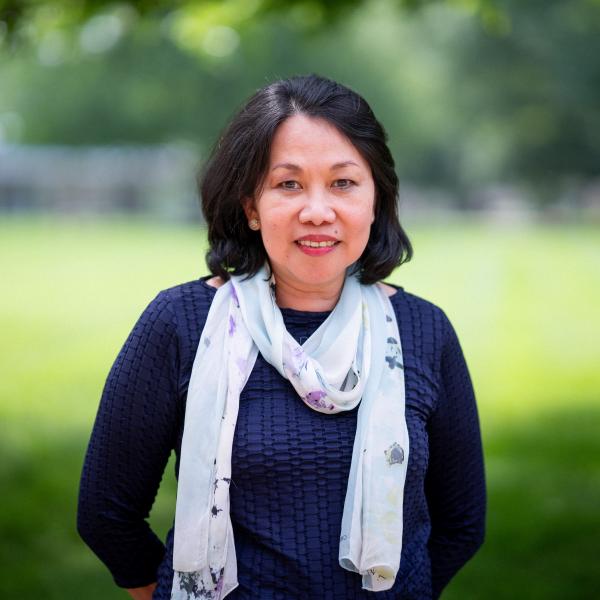We're celebrating Black History Month with a closer look at some of our favorite scientists and STEM professionals. These individuals were selected by members of the Chemistry DEI committee for their inspirational research, teaching, and leadership.
Winifred Burks-Houck
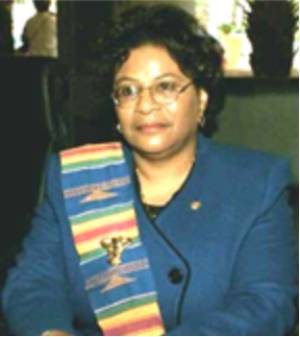
Winifred Burks-Houck (1950-2004) was an environmental organic chemist and the first woman president of the National Organization for the Professional Advancement of Black Chemists and Chemical Engineers (NOBCChE), where she served from 1993 until 2001. She was born in Anniston, Alabama on August 20, 1950 and is the great, great, great granddaughter of abolitionist Harriet Tubman.
Burks-Houck received a Bachelor of Arts degree in chemistry from Dillard University in New Orleans and a Master of Science degree in organic chemistry from Atlanta University in Atlanta, Georgia. In 1983, she joined the Lawrence Livermore National Laboratory in Livermore, CA as an environmental chemist. She worked analyzing environmental hazards, minimizing potential threats to worker safety, and ensuring that the lab minimized environmental impacts during its operation.
Best remembered for her leadership in advancing Black chemists, Burks-Houck was critical in the establishment of NOBCChe on the West Coast. She served as president for an unprecedented four consecutive terms, where she was remembered for her unique brand of leadership, positive attitude, and devotion to the advancement of other black members. After her death in 2004, NOBCChE honored Burks-Houck by establishing the Winifred Bucks-Houck Professional Leadership Lecture, Awards, and Symposium. It recognizes professional women and students, for their achievement in science, technology, engineering, and math; leadership; and entrepreneurship.
Kenneth Carleton Frazier
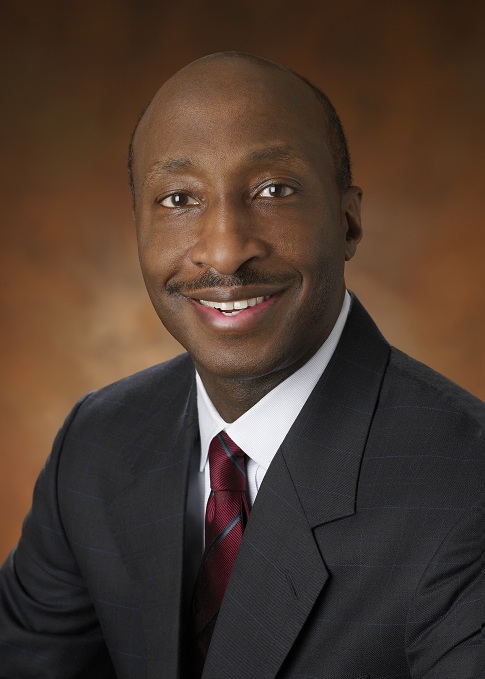
Kenneth Carleton Frazier, 66, is the chairman and CEO of Merck & Co. He is the first African American man to lead a major pharmaceutical company and one of only a handful (four to be exact) of Black CEOs to lead a Fortune 500 company.
Frazier is a Harvard-trained attorney that was born and raised as the son of a janitor in North Philadelphia. His father, Otis Frazier, was the son of a South Carolina sharecropper. Otis was self-educated and instilled in his three children a love of reading and lessons of hard work. Kenneth lost his mother, Clara Frazier, at age 12. He wasted no time rising up as a self-made success graduating high school at 16, Penn State at 19, and Harvard Law at 23.
Frazier was a partner at the Drinker, Biddle, and Reath law firm in Philadelphia. In 1992, he joined Merck & Co as general council. He led the company through more than 5,000 lawsuits surrounding toxicity allegations of the drug Vioxx. After working his way up to vice president and then president, he was ultimately promoted to chairmen & CEO in 2011 where he prioritized research funding over earnings, doubled the company’s valuation under his leadership, and orchestrated a series of major acquisitions including the $41 billion deal for Schering-Plow in 2009. Frazier is credited with solidifying Merck as a leader in the development of immunotherapy drugs where Keytruda (pembrolizumab), a humanized antibody targeting the programmed cell death protein 1 (PD-1) receptor of lymphocytes, has become the best- selling drug of its class topping $14 billion in 2020 sales.
Beyond his leadership skills as a gifted attorney and businessman, Frazier is recognized as an advocate for minority advancement in the sciences and business. He famously was the first to resign as a member of the President’s American Manufacturing Council in 2017 when then-President Donald Trump failed to immediately condemn the acts of violence by white supremacists at the 2017 Unite the Right rally in Charlottesville, VA. Frazier has received numerous awards for his promotion of social justice and commitment to secure one million Black Americans into family-sustaining jobs through his OneTen coalition. After 29 years with Merck & Co, 11 as CEO, Frazier announced his retirement on February 4, 2021. He leaves Merck with momentum to continue leading in the pharmaceutical sector and address health disparities in developing countries and underrepresented groups.
Ben Carson
Ben Carson, 69, is a world renowned (and now retired) pediatric neurosurgeon famously known for his miraculous and groundbreaking surgery in 1987 to successfully separate twins who were joined at the head. “We are all capable of performing miracles,” said Carson.
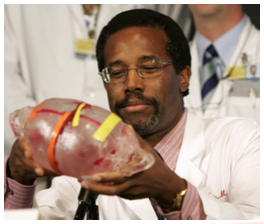
After graduating from the School of Medicine at the University of Michigan, Carson interned at John Hopkins hospital where he became the chief resident in neurosurgery. 1985, Carson became the director of pediatric neurosurgery at John Hopkins hospital at the age of 33, the youngest US physician to hold such a position at the time. In 2008, former President George W. Bush honored Carson with the Presidential Medal of Freedom, the highest award given to a civilian.
Carson came from poor and humble beginnings in the inner city of Detroit, where he was raised by a single mother. He struggled in school and was labeled as "dump" in his early years. Trying to turn her son’s fortune around, his mother limited Carson's time on the television, believing that too much television was responsible for his poor performance in school. Her strict regimen also required Carson to read two library books on a weekly basis and provide written reports to her, although she could not read.
In his childhood years, Carson had his own anger issues. In his autobiography, he stated that he once tried to hit his mother with a hammer because she disagreed with his choice of clothes. Needing an intervention with these episodes of anger, he turned to God by reading the Bible. This shaped and put him on the right path to the man he later became. Following this intervention, Carson received a certificate of achievement in the eighth grade for being at the top of his class. This was the beginning of better days ahead and a sign of a brighter future. After graduating from Southwestern high school (in Detroit) with honors, Carson earned a full scholarship to Yale where he received a BA degree in psychology in 1973.
For more information about Carson's groundbreaking surgery and childhood life, we encourage you to watch the film Gifted Hands.
Angie Turner King
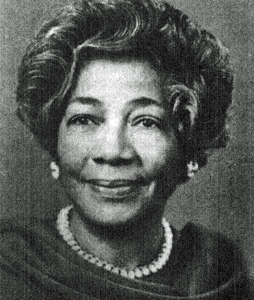
Angie Lena Turner King (1905-2004) was a chemist, mathematician, and educator. She was the first African-American woman to receive a PhD in mathematics education in 1955. She dedicated her life and career to teaching in high schools and colleges and had great influence on many of her students, including NASA mathematician Katherine Johnson, a subject of Hidden Figures: The American Dream and the Untold Story of the Black Women Who Helped Win the Space Race (2016).
King was born in 1905 in West Virginia, in the segregated coal-mining community of Elkhorn. She lost her mother at the age of 8. In order to pay for her tuition, she worked at numerous jobs, including waitressing and dishwashing. Following a Bachelor of Science degree in chemistry and mathematics, she started a career in education at West Virginia State High School where she also directed a high-school play as part of her support of student activities. During the summers, she attended graduate school at Cornell University and received her master’s degree in physical chemistry in 1931. After receiving a teaching position as an associate professor at West Virginia State College, she made sure to refurbish the lab to show students “what a real laboratory was like.”
During World War II, King taught chemistry to soldiers in an Army Specialized Training Program (ASTP) at West Virginia State College. In 1955, she received her PhD from University of Pittsburgh. With a continued focus on teaching, her master’s and doctoral thesis entitled “An Analysis of Early Algebra Textbooks Used in American Secondary Schools before 1900” remained her only published research.
While traveling to Africa in the 1970s, King obtained information on the Status of Women in East Africa. She was the chair of the West Virginia Governor's Commission on the Status of Women in 1975 and West Virginia State College's Division of Natural Resources and Mathematics before retiring from the college in 1980. She continued to live in her on-campus house until she died at the age of 99 in 2004. King was married and had five daughters.
Saint Elmo Brady
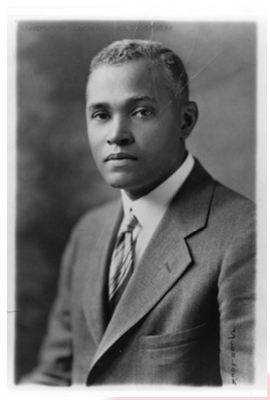
Saint Elmo Brady (1884-1966) was the first Black American to receive a PhD in Chemistry in the US. Born in Louisville, Kentucky, Brady was the eldest of three children and lived in a segregated community, experiencing challenges finding housing. Brady received his high school degree at Louisville Colored High School in 1903 and attended Fisk College (now Fisk University). It was at Fisk that Brady’s chemistry instructor encouraged him to continue in the field. Brady then served as an instructor at Tuskegee Normal and Industrial Institute (now Tuskegee University), before accepting a scholarship in 1913 at University of Illinois, Urbana-Champaign (UIUC). Brady received his MS from UIUC in 1914 and began working for Professor Clarence G. Derick.
Under Derick’s guidance, Brady published three abstracts in Science in 1914 and 1915 and collaborated on a project with UIUC Professor Goerge Beal, yielding the paper, “The Hydrochloride Method for the Determination of Alkaloids,” published in the Journal of Industrial and Engineering Chemistry. Brady’s research focus was on changes in acidity of carboxylic acids upon replacing carbon chain hydrogens with other substituents, specifically straight chain carboxylic acids with hydrogen pairs changed for oxygen to yield a keto acid (e.g., pyruvic acid). Brady’s work yielded methods to prepare and purify organic compounds and an early understanding of the effects of carbonyl groups on carboxylic acid acidity. Brady defended his thesis “The Scale of Influence of Substituents in Paraffine Monobasic Acids. The Divalent Oxygen Atom” in 1916 after just two years of study, as the 40th person to receive a PhD at University of Illinois and the first Black American Chemist in the US.
Actively turning down the opportunity to financially benefit from a career in industry, Brady’s greatest legacy is his development of curricula, faculty, programs, and facilities at Historically Black Colleges and Universities (HBCUs)—Tuskegee University, Howard University, Fisk University, and Tougaloo College. In addition to learning about Brady, we recommend that you read about the rich histories of each of these institutions. Some of Brady’s contributions: at Tuskegee, development of undergraduate program in chemistry as head of Division of Science; at Howard, as chair of department (1920), development of program to better prepare students for graduate school, as well as the first chemistry graduate program at an HBCU and a new chemistry building; at Fisk, as department chair (1927), where he stayed for 25 years, teaching hundreds of students, assembling distinguished faculty, beginning a lectureship series, raising funds to acquire one of the first IR spectrophotometers, establishing a summer program in collaboration with UIUC, and founding of the Infrared Spectroscopy Institute with Fisk’s physics department; at Tougaloo University, after retiring, where Brady spent 14 years helping build their chemistry department.
References:
C&EN's "Black chemists you should know about"
NOBCChE's profile of Winifred Burks-Houck
Wikipedia entry "Kenneth Frazier"
PBS profile of Ken Frazier (video)
"Longtime Merck CEO, minority advocate Ken Frazier to retire"
The History Makers biography of Kenneth C. Frazier
Wikipedia entry "Ben Carson"
AAREG entry on "Angie Lena Turner King"
Wikipedia entry on "Angie Turner King"
ACS's profile of Angie Turner King
BlackPast.org's profile of Angie Turner King
ACS's profile of St. Elmo Brady
"St. Elmo Brady (1884-1966): Pioneering Black Academic Chemist"
Wikipedia entry on St. Elmo Brady


